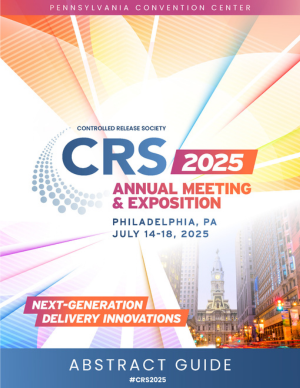Industry Session
Workshop: Diagnostics with Phospholipids - Quality standards and areas of application
Theranostic Phospholipid-Coated Ultrasound Contrast Agents for Vascular Disease and Biofilm Infections
Monday, July 14, 2025
3:20 PM - 3:40 PM EDT
Location: 119 A
Sponsored By


Ultrasound-activated vibrating microbubbles (1-10 µm in size) have shown preclinical potential to boost drug therapy and reduce side-effects for treating cardiovascular disease and cancer because drugs are delivered locally [1]. The majority of the clinically approved microbubbles consist of a gas core that is stabilized by a coating of phospholipids [2]. Recently, safety of microbubble-mediated treatment was demonstrated in several clinical trials [3]. Despite the advances in the field, the underlying mechanism of microbubble-mediated drug delivery are poorly understood [1]. One of the reasons for this is the huge range in time scales involved. The time scale of the microbubble vibration is 2 million times per second in a 2 MHz ultrasound field (microseconds), which is many orders of magnitude smaller than the time scale of physiological effects (milliseconds), let alone that of biological effects (seconds to minutes) and clinical relevance (days to months). To allow the investigation of the microbubble-cell-drug interaction at a microsecond and micrometer resolution, unique technology was created by coupling an ultra-high-speed camera (~20 million frames per second recordings) to a custom-built confocal microscope [4]. In this workshop, I will show how microbubbles vibrate to ultrasound by showing ultra-high-speed camera recordings. I will then explain about the influence of different phospholipid coatings on the acoustical behavior of the microbubbles and give an example for microbubble-mediated vascular drug delivery and targeted microbubble-mediated bacterial biofilm treatment and ultrasound molecular imaging.
References:
[1] Kooiman K, Roovers S, Langeveld SAG, Kleven RT, Dewitte H, O'Reilly MA, Escoffre JM, Bouakaz A, Verweij MD, Hynynen K, Lentacker I, Stride E and Holland CK. Ultrasound-Responsive Cavitation Nuclei for Therapy and Drug Delivery. Ultrasound Med Biol. 2020;46:1296-1325. doi 10.1016/j.ultrasmedbio.2020.01.002.
[2] Frinking P, Segers T, Luan Y and Tranquart F. Three Decades of Ultrasound Contrast Agents: A Review of the Past, Present and Future Improvements. Ultrasound Med Biol. 2020;46:892-908. doi 10.1016/j.ultrasmedbio.2019.12.008.
[3] Bouakaz A and Michel Escoffre J. From concept to early clinical trials: 30 years of microbubble-based ultrasound-mediated drug delivery research. Adv Drug Deliver Rev. 2024;206:115199. doi 10.1016/j.addr.2024.115199.
[4] Beekers I, Lattwein KR, Kouijzer JJP, Langeveld SAG, Vegter M, Beurskens R, Mastik F, Verduyn Lunel R, Verver E, van der Steen AFW, de Jong N and Kooiman K. Combined Confocal Microscope and Brandaris 128 Ultra-High-Speed Camera. Ultrasound Med Biol. 2019;45:2575-2582. doi 10.1016/j.ultrasmedbio.2019.06.004.
References:
[1] Kooiman K, Roovers S, Langeveld SAG, Kleven RT, Dewitte H, O'Reilly MA, Escoffre JM, Bouakaz A, Verweij MD, Hynynen K, Lentacker I, Stride E and Holland CK. Ultrasound-Responsive Cavitation Nuclei for Therapy and Drug Delivery. Ultrasound Med Biol. 2020;46:1296-1325. doi 10.1016/j.ultrasmedbio.2020.01.002.
[2] Frinking P, Segers T, Luan Y and Tranquart F. Three Decades of Ultrasound Contrast Agents: A Review of the Past, Present and Future Improvements. Ultrasound Med Biol. 2020;46:892-908. doi 10.1016/j.ultrasmedbio.2019.12.008.
[3] Bouakaz A and Michel Escoffre J. From concept to early clinical trials: 30 years of microbubble-based ultrasound-mediated drug delivery research. Adv Drug Deliver Rev. 2024;206:115199. doi 10.1016/j.addr.2024.115199.
[4] Beekers I, Lattwein KR, Kouijzer JJP, Langeveld SAG, Vegter M, Beurskens R, Mastik F, Verduyn Lunel R, Verver E, van der Steen AFW, de Jong N and Kooiman K. Combined Confocal Microscope and Brandaris 128 Ultra-High-Speed Camera. Ultrasound Med Biol. 2019;45:2575-2582. doi 10.1016/j.ultrasmedbio.2019.06.004.

Klazina Kooiman, PhD (she/her/hers)
Associate Professor
Biomedical Engineering, Dept. of Cardiology, Erasmus MC
Rotterdam, Netherlands

